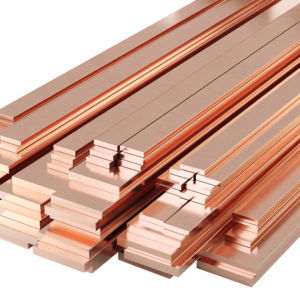1. Introduction
When you hear ‘copper rod,’ you might picture basic wiring or plumbing. But in advanced engineering and industrial applications, copper rods are anything but ordinary. From safeguarding skyscrapers against lightning strikes to enabling flawless joints in high-purity piping systems, specialized copper rods play a pivotal role.

This article dives into two high-stakes, niche applications where the performance of copper rod is non-negotiable: electrical earthing (grounding) and precision copper welding. We’ll also touch on related forms like copper strip and copper round bar that often complement these systems.
2. Copper Rod in Electrical Earthing Systems
Electrical safety in buildings, power stations, and telecom towers hinges on effective grounding. That’s where the copper earth rod—also called an earthing rod copper or ground rod copper—comes in.
Pure copper rods offer excellent conductivity and long-term corrosion resistance, but they’re expensive. Enter the copper bonded earthing rod: a steel core electroplated with a thick layer of pure copper. This hybrid—also known as copper bonded steel, copper clad ground rod, or copper clad earth rod—delivers 90% of copper’s performance at a fraction of the cost.
- Copper bonded ground rods are ideal for rocky or high-resistivity soils.
- Standards often require a minimum copper thickness of 0.25mm for durability.
- The copper earth strip 25x3mm price is frequently compared when designing grid-based earthing mats.
For large installations, engineers may combine copper rods with flat copper strip or copper strip for earthing to create low-resistance grounding grids. These strips—available as thin copper strips, 1mm copper strip, or nickel plated copper strip—offer flexibility in layout and connection.
When sourcing materials, buyers often search for ‘copper strip near me’ or check ‘earthing rod price’ versus ‘copper rod price’ to balance budget and performance.

3. Precision Welding and Brazing with Copper Rod
In HVAC, semiconductor manufacturing, and high-purity fluid systems, joining copper components without contamination is critical. That’s where copper welding rod and copper brazing rod shine.
Unlike steel welding, copper-to-copper welding requires filler metals that match the base metal’s thermal and electrical properties. Hence, professionals use copper to copper welding rod or copper to copper brazing rods designed specifically for this purpose.
Copper rod for welding must be oxygen-free or deoxidized to prevent porosity. Common types include:
- Phosphorus-deoxidized copper rods for air conditioning copper pipe joints.
- Silver-bearing copper brazing rods for stronger, leak-proof seals in ac copper pipe systems.
Technicians working on aircon copper tube repairs often prefer copper rod welding because it maintains system integrity without introducing foreign alloys. This is especially vital in medical gas lines or food-grade piping where purity matters.
Note: While ‘copper pipe soldering’ is common in residential plumbing, industrial applications often demand true brazing or welding using dedicated copper welding rod—not standard solder.

4. Complementary Forms: Copper Strip, Round Bar, and More
Beyond rods, other copper forms support these niche applications. For instance, flexible copper bus bar or copper flat bar may connect multiple earthing rods in a substation. Meanwhile, beryllium copper strip or copper beryllium strip offers spring-like properties for electrical contacts in aerospace systems.
Recycling and fabrication shops often deal with stripping copper wire for scrap. Though methods like ‘burning copper wire for scrap’ exist, they’re discouraged due to toxic fumes. Instead, the best way to strip copper wire involves mechanical strippers—especially when recovering copper strip wire or preparing material for resale.
For roofing or architectural detailing, copper roof strip and copper edging strip provide both function and aesthetics. And in electronics, roll of copper strip or copper strip roll in widths like 1mm copper strip feeds into PCB manufacturing.
Prices vary widely: ‘copper strip price’ depends on thickness and alloy, while ‘copper ingot price’ influences raw material costs for custom copper round bar production.
5. Choosing the Right Type for Your Project
Not all copper rods are equal. Consider these factors:
- Environment: Use solid copper rod in highly corrosive areas; copper bonded steel suffices for most soil conditions.
- Conductivity needs: Pure copper round bar outperforms clad alternatives in high-current scenarios.
- Joining method: For HVAC work on 15mm copper pipe or 22mm copper tube, select a copper brazing rod compatible with your flux and torch setup.
- Cost vs. lifespan: While copper rod price may seem high upfront, its decades-long service life often justifies the investment—especially compared to cheaper but shorter-lived alternatives.
6. Conclusion
From protecting critical infrastructure with copper earth rods to enabling ultra-clean joints in air conditioning copper pipe systems, copper rod proves its worth far beyond basic construction. Whether you’re specifying a copper bonded ground rod for a solar farm or selecting copper to copper brazing rods for a pharmaceutical plant, understanding these niche applications ensures reliability, safety, and performance. As technology advances, the demand for high-purity, precisely engineered copper forms—from rod to strip to bar—will only grow.
Our Website founded on October 17, 2012, is a high-tech enterprise committed to the research and development, production, processing, sales and technical services of ceramic relative materials such as Copper. Our products includes but not limited to Boron Carbide Ceramic Products, Boron Nitride Ceramic Products, Silicon Carbide Ceramic Products, Silicon Nitride Ceramic Products, Zirconium Dioxide Ceramic Products, etc. If you are interested, please feel free to contact us.

